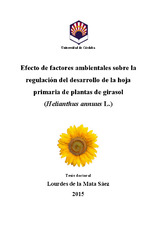Mostrar el registro sencillo del ítem
Efecto de factores sobre la regulación del desarrollo de la hoja primaria de plantas de girasol
| dc.contributor.advisor | Agüera Buendía, Eloísa | |
| dc.contributor.advisor | Haba Buendía, Purificación de la | |
| dc.contributor.author | Mata Sáez, Lourdes de la | |
| dc.date.accessioned | 2016-04-05T08:47:58Z | |
| dc.date.available | 2016-04-05T08:47:58Z | |
| dc.date.issued | 2016 | |
| dc.identifier.uri | http://hdl.handle.net/10396/13392 | |
| dc.description.abstract | Los procesos bioquímicos, biológicos y morfogenéticos de las plantas de girasol (Helianthus annuus L.) y en general de todas las plantas, se ven afectados por el cambio climático en curso, produciendo alteraciones en el desarrollo, crecimiento y productividad de los cultivos. El cambio climático actual está produciendo modificaciones en los ecosistemas siendo importante el estudio de plantas con mayor capacidad adaptativa a las modificaciones medioambientales. En el presente trabajo se han estudiado los cambios fisiológicos y metabólicos que ocurren en las plantas de girasol durante su desarrollo, bajo diferentes factores ambientales: elevada concentración de dióxido de carbono (CO2) atmosférico, elevada temperatura y variaciones en la intensidad lumínica. Para ello hemos enfocado este estudio abordando, en diferentes capítulos, estos tres factores ambientales: elevada concentración atmosférica de CO2 (Capítulo I y II) modificación en la intensidad luminosa (Capítulo III), y elevada temperatura (Capítulo IV). Se han determinado las variaciones en los parámetros de crecimiento, así como los cambios en el contenido de pigmentos fotosintéticos, asimilación fotosintética de CO2, contenido en carbohidratos, actividades y niveles de expresión de enzimas del metabolismo del nitrógeno y el estado oxidativo del tejido vegetal. En general, se ha observado que los diferentes factores ambientales provocan en las plantas de girasol alteraciones que inducen la aceleración del proceso de senescencia en la hoja primaria, cuyo principal fin es la movilización de nutrientes a los órganos en crecimiento para mantener su funcionalidad. Estos resultados contribuyen al conocimiento de los efectos que el calentamiento global va a tener sobre los diferentes cultivos ya que los factores ambientales estudiados pueden verse afectados por él. Este estudio se ha realizado en plantas de girasol debido a la gran importancia del cultivo, ya que su uso es fundamental en la alimentación humana (semilla o aceite) y de animales (forraje), también es importante por su utilización en procesos de biorremediación y en la producción de biodiesel así como por su valor ornamental. | es_ES |
| dc.description.abstract | Climate change is affecting the biochemical, biological and morphogenetic processes in sunflower plants (Helianthus annuus L.) and in all plants, producing alterations in growth, development and productivity of the crops. The current climate change is causing changes in the ecosystems; therefore, the study of plants with increased ability to adapt to these environmental changes is important. In this work, physiological and metabolic changes during the development of sunflower plants under different atmospheric conditions have been studied. These plants were subjected to high atmospheric CO2 concentration, high temperature and variations in light intensity. The responses to the different conditions were addressed in different chapters of this thesis: high atmospheric CO2 concentration (chapters I and II), changes in the light intensity (chapter III) and high temperature (chapter IV). During this project, different growth related parameters were measured such as the content of photosynthetic pigments, CO2 photosynthetic fixation, content of carbohydrates, activity and level of expression of enzymes related to the nitrogen metabolism and the plant tissue oxidative state. In general, it was observed that different environmental factors resulted in alterations in sunflower plants; which induced the acceleration of the process of senescence in primary leaves. The main aim of this process is to transport nutrients to the young tissues in order to maintain their functionality. These results add insight into the knowledge of the effects of global warming on sunflower crops since the studied atmospheric factors might be affected by it. This study was conducted in sunflower plants because of their importance as a crop. The use of sunflower is essential in the diet of humans (seeds and oil) and animals (fodder). Its use is also important in bioremediation, biodiesel production and ornamental use. | es_ES |
| dc.format.mimetype | application/pdf | es_ES |
| dc.language.iso | spa | es_ES |
| dc.publisher | Universidad de Córdoba, UCOPress | es_ES |
| dc.rights | https://creativecommons.org/licenses/by-nc-nd/4.0/ | es_ES |
| dc.subject | Girasol (Helianthus annuus L.) | es_ES |
| dc.subject | Cambios fisiológicos | es_ES |
| dc.subject | Cambios metabólicos | es_ES |
| dc.subject | Factores ambientales | es_ES |
| dc.title | Efecto de factores sobre la regulación del desarrollo de la hoja primaria de plantas de girasol | es_ES |
| dc.type | info:eu-repo/semantics/doctoralThesis | es_ES |
| dc.rights.accessRights | info:eu-repo/semantics/openAccess | es_ES |

